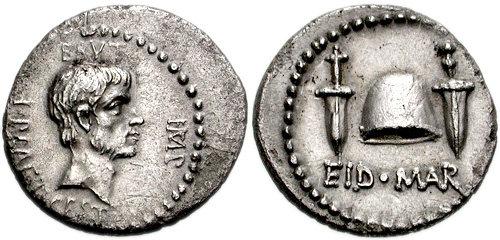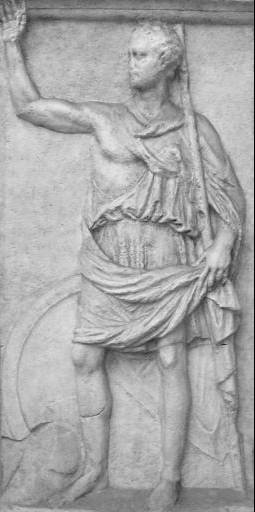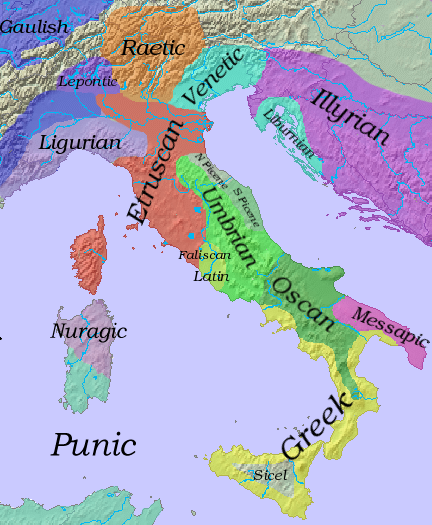|
Roman Republican Civil Wars
This list of Roman civil wars and revolts includes civil wars and organized civil disorder, revolts, and rebellions in ancient Rome (Roman Kingdom, Roman Republic, and Roman Empire) until the fall of the Western Roman Empire (753 BC – AD 476). For the Eastern Roman Empire or Byzantine Empire after the division of the Empire in West and East, see List of Byzantine revolts and civil wars (AD 330–1453). For external conflicts, see List of Roman external wars and battles. From the establishment of the Roman Republic in 509 BC until the 1st century BC, there were a sparse number of civil wars. But with the Crisis of the Roman Republic (134–44 BC), a period of considerable political instability began. The cause of the late Roman Republican civil wars is contested, as is whether the wars were the cause of, or caused by, the end of the Roman Republic. Regardless, a nearly constant stream of civil wars marked the end of the Roman Republic and heralded the rise of the Roman Empire ... [...More Info...] [...Related Items...] OR: [Wikipedia] [Google] [Baidu] |
Civil War
A civil war is a war between organized groups within the same Sovereign state, state (or country). The aim of one side may be to take control of the country or a region, to achieve independence for a region, or to change government policies.James Fearon"Iraq's Civil War" in ''Foreign Affairs'', March/April 2007. For further discussion on civil war classification, see #Formal classification, the section "Formal classification". The term is a calque of Latin which was used to refer to the various Roman civil wars, civil wars of the Roman Republic in the 1st century BC. Most modern civil wars involve intervention by outside powers. According to Patrick M. Regan in his book ''Civil Wars and Foreign Powers'' (2000) about two thirds of the 138 intrastate conflicts between the end of World War II and 2000 saw international intervention. A civil war is often a high-intensity conflict, often involving Regular army, regular armed forces, that is sustained, organized and large-scale. C ... [...More Info...] [...Related Items...] OR: [Wikipedia] [Google] [Baidu] |
Caesar's Assassination
Julius Caesar, the Roman dictator, was assassinated on the Ides of March (15 March) 44 BC by a group of senators during a Senate session at the Curia of Pompey, located within the Theatre of Pompey in Rome. The conspirators, numbering between 60 and 70 individuals and led by Marcus Junius Brutus, Gaius Cassius Longinus, and Decimus Junius Brutus Albinus, stabbed Caesar approximately 23 times. They justified the act as a preemptive defense of the Roman Republic, asserting that Caesar's accumulation of lifelong political authority—including his perpetual dictatorship and other honors—threatened republican traditions. The assassination failed to achieve its immediate objective of restoring the Republic's institutions. Instead, it precipitated Caesar's posthumous deification, triggered the Liberators' civil war (43–42 BC) between his supporters and the conspirators, and contributed to the collapse of the Republic. These events ultimately culminated in the rise of the Ro ... [...More Info...] [...Related Items...] OR: [Wikipedia] [Google] [Baidu] |
Sicily (Roman Province)
Sicilia (; ; ) was the first province acquired by the Roman Republic, encompassing the island of Sicily. The western part of the island was brought under Roman control in 241 BC at the conclusion of the First Punic War with Carthage. A praetor was regularly assigned to the island from . The Kingdom of Syracuse under Hieron II remained an independent ally of Rome until its defeat in 212 BC during the Second Punic War. Thereafter the province included the whole of the island of Sicily, the island of Malta, and the smaller island groups (the Egadi islands, the Lipari islands, Ustica, and Pantelleria). During the Roman Republic, the island was the main source of grain for the city of Rome. Extraction was heavy, provoking armed uprisings known as the First and Second Servile Wars in the second century BC. In the first century, the Roman governor, Verres, was famously prosecuted for his corruption by Cicero. In the civil wars which brought the Roman Republic to an end, Sicily wa ... [...More Info...] [...Related Items...] OR: [Wikipedia] [Google] [Baidu] |
First Servile War
The First Servile War of 135–132 BC was a slave rebellion against the Roman Republic, which took place in Sicily. The revolt started in 135 when Eunus, a slave from Syria who claimed to be a prophet, captured the city of Enna in the middle of the island with 400 fellow slaves. Soon after, Cleon, a Cilician slave, stormed the city of Agrigentum on the southern coast, slaughtered the population, and then joined Eunus' army and became his military commander. Eunus even proclaimed himself king, under the name of Antiochus, after the Seleucid emperors of his native Syria. The former slaves then moved to the eastern coast and took control of Catana and Tauromenium. Their exploit triggered several minor revolts in Italy and as far as Delos in the Aegean Sea. Eunus and Cleon were able to repel several Roman attempts to quell the rebellion until an army commanded by consul Publius Rupilius arrived in Sicily in 134 and besieged the cities controlled by the slaves. The revolt en ... [...More Info...] [...Related Items...] OR: [Wikipedia] [Google] [Baidu] |
Second Punic War
The Second Punic War (218 to 201 BC) was the second of Punic Wars, three wars fought between Ancient Carthage, Carthage and Roman Republic, Rome, the two main powers of the western Mediterranean Basin, Mediterranean in the 3rd century BC. For 17 years the two states struggled for supremacy, primarily in Roman Italy, Italy and Iberia, but also on the islands of Sicily and Sardinia and, towards the end of the war, in North Africa. After immense materiel and human losses on both sides, the Carthaginians were once again defeated. Macedonia (ancient kingdom), Macedonia, Kingdom of Syracuse, Syracuse and several Numidians, Numidian kingdoms were drawn into the fighting, and Celtiberians, Iberian and Gauls, Gallic forces fought on both sides. There were three main Theater (military), military theatres during the war: Italy, where Hannibal defeated the Roman legions repeatedly, with occasional subsidiary campaigns in Sicily, Sardinia and Greece; Iberia, where Hasdrubal (Barcid), Hasdru ... [...More Info...] [...Related Items...] OR: [Wikipedia] [Google] [Baidu] |
Italic Peoples
The concept of Italic peoples is widely used in linguistics and historiography of ancient Italy. In a strict sense, commonly used in linguistics, it refers to the Osco-Umbrian languages, Osco-Umbrians and Latino-Faliscan languages, Latino-Faliscans, speakers of the Italic languages, a subgroup of the Indo-European languages, Indo-European language family. In a broader sense, commonly used in historiography, all the ancient peoples of Italy are referred to as Italic peoples, including the non-Indo-European ones, as Rhaetian people, Rhaetians, Ligures and Etruscan civilization, Etruscans. As the Latins (Italic tribe), Latins achieved a dominant position among these tribes, by virtue of the expansion of the Ancient Rome, Roman civilization, the other Italic tribes adopted Latin language and culture as part of the process of Romanization (cultural), Romanization. Classification The Italics were an ethnolinguistic group who are identified by their use of the Italic languages, which ... [...More Info...] [...Related Items...] OR: [Wikipedia] [Google] [Baidu] |
Falisci
The Falisci were an Italic peoples, Italic tribe who lived in what is now northern Lazio, on the Etruscan side of the Tiber River. They spoke an Italic languages, Italic language, Faliscan language, Faliscan, closely related to Latin. Originally a sovereign state, politically and socially they supported the Etruscan civilization, Etruscans, joining the Etruscan League. This conviction and affiliation led to their ultimate near destruction and total subjugation by Rome. Only one instance of their own endonym has been found to date: an inscription from Falerii Novi from the late 2nd century AD refers to the ', "the Faliscans who are in Sardinia", where ' is the nominative plural case. An Etruscan inscription calls them the '. The Latin cannot be far different from the original name. The -sc- suffix is "distinctive of the Italic ethnonyms". Geography The Falisci resided in a region called by the Romans the ', "Faliscan Country", located on the right bank of the Tiber River betwe ... [...More Info...] [...Related Items...] OR: [Wikipedia] [Google] [Baidu] |
Volsinii
Volsinii or Vulsinii (Etruscan language, Etruscan: Velzna or Velusna; Ancient Greek, Greek: Ouolsinioi, ; ), is the name of two ancient cities of Etruria, one situated on the shore of Lacus Volsiniensis (modern Lago di Bolsena), and the other on the Via Clodia, between Clusium (Chiusi) and Forum Cassii (Vetralla). The latter was Etruscan civilization, Etruscan and was destroyed by the Romans in 264 BC following an attempted revolt by its slaves, while the former was founded by the Romans using the remainder of the Etruscan population rescued from the razed city. Modern Bolsena, Italy, in the region of Lazio, descends from the Roman city. The location of the Etruscan city is debated. Umbrian Orvieto, about from Bolsena, is a strong candidate. Situation The Byzantine Empire, Byzantine historian Joannes Zonaras states that the Etruscan Volsinii (Velzna or Velusna) lay on a steep height;Zonaras, ''Annals'' (or ''Chronicle'' or ''Epitome'' - he does not state a name of his own) vii ... [...More Info...] [...Related Items...] OR: [Wikipedia] [Google] [Baidu] |
Picentes
The Picentes or Piceni or Picentini were an ancient Italic peoples, Italic people who lived from the 9th to the 3rd century BC in the area between the Foglia and Aterno rivers, bordered to the west by the Apennines and to the east by the Adriatic coast. Their territory, known as ''Picenum'', therefore included all of today's Marche and the northern part of Abruzzo. Piceni derived their culture and genetic ancestry from the Early Bronze Age Cetina culture at the other side of the Adriatic Sea, and Late Bronze Age Hallstatt culture along the Danube River, as a 2024 study confirms. The limits of Picenum depend on the era; during the early classical antiquity the region between the Apennine Mountains, Apennines and the Adriatic Sea south of Ancona was Picenum (South Picenians), while between Ancona and Rimini to the north the population was multi-ethnic (North Picenians) because after 390 BC the Senones, Senoni Gauls had combined with or supplanted earlier populations. In the Roman Re ... [...More Info...] [...Related Items...] OR: [Wikipedia] [Google] [Baidu] |
Samnites
The Samnites () were an ancient Italic peoples, Italic people who lived in Samnium, which is located in modern inland Abruzzo, Molise, and Campania in south-central Italy. An Oscan language, Oscan-speaking Osci, people, who originated as an offshoot of the Sabines, they formed a confederation consisting of four tribes: the Hirpini, Caudini, Caraceni (tribe), Caraceni, and Pentri. Ancient Greek historians considered the Umbri as the ancestors of the Samnites. Their migration was in a southward direction, according to the rite of ver sacrum. Although allied together against the Gauls in 354 BC, they later became enemies of the Roman Republic, Romans and fought them in a series of Samnite Wars, three wars. Despite an overwhelming victory at the Battle of the Caudine Forks (321 BC), the Samnites were subjugated in 290 BC. Although severely weakened, the Samnites would still side against the Romans, first in the Pyrrhic War and then with Hannibal in the Second Punic War. They also foug ... [...More Info...] [...Related Items...] OR: [Wikipedia] [Google] [Baidu] |
Patrician (ancient Rome)
The patricians (from ) were originally a group of ruling class families in ancient Rome. The distinction was highly significant in the Roman Kingdom and the early Roman Republic, Republic, but its relevance waned after the Conflict of the Orders (494 BC to 287 BC). By the time of the late Republic and Roman Empire, Empire, membership in the patriciate was of only nominal significance. The social structure of ancient Rome revolved around the distinction between the patricians and the plebeians. The status of patricians gave them more political power than the plebeians, but the relationship between the groups eventually caused the Conflict of the Orders. This time period resulted in changing of the social structure of ancient Rome. After the Western Roman Empire, Western Empire fell, the term "patrician" continued as a high Byzantine aristocracy and bureaucracy, honorary title in the Eastern Empire. In many Italian city-states, medieval Italian republics, especially in Republic of V ... [...More Info...] [...Related Items...] OR: [Wikipedia] [Google] [Baidu] |
Plebeians
In ancient Rome, the plebeians or plebs were the general body of free Roman citizens who were not Patrician (ancient Rome), patricians, as determined by the Capite censi, census, or in other words "commoners". Both classes were hereditary. Etymology The precise origins of the group and the term are unclear, but may be related to the Greek, ''plēthos'', meaning masses. In Latin, the word is a grammatical number, singular collective noun, and its genitive is . Plebeians were not a monolithic social class. In ancient Rome In the annalistic tradition of Livy and Dionysius of Halicarnassus, Dionysius, the distinction between patricians and plebeians was as old as Rome itself, instituted by Romulus' appointment of the first hundred senators, whose descendants became the patriciate. Modern hypotheses date the distinction "anywhere from the regal period to the late fifth century" BC. The 19th-century historian Barthold Georg Niebuhr believed plebeians were possibly foreigners im ... [...More Info...] [...Related Items...] OR: [Wikipedia] [Google] [Baidu] |








